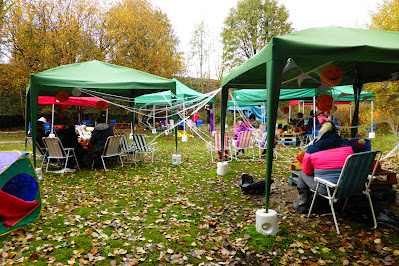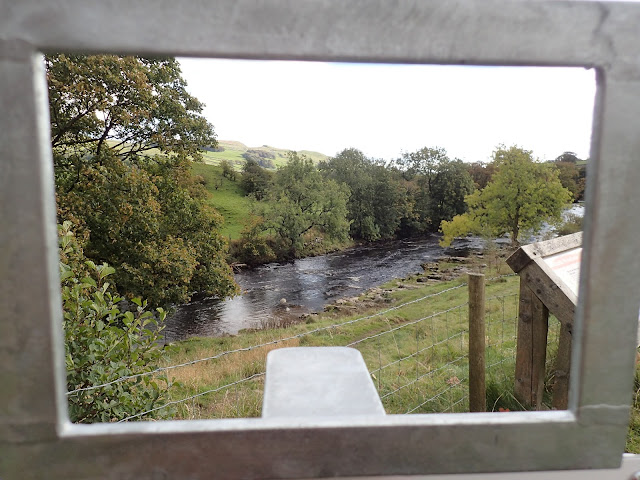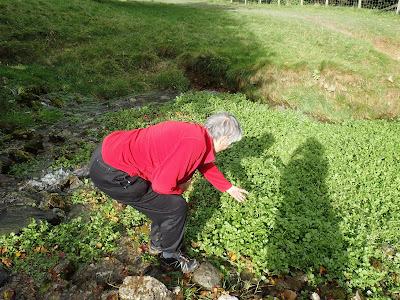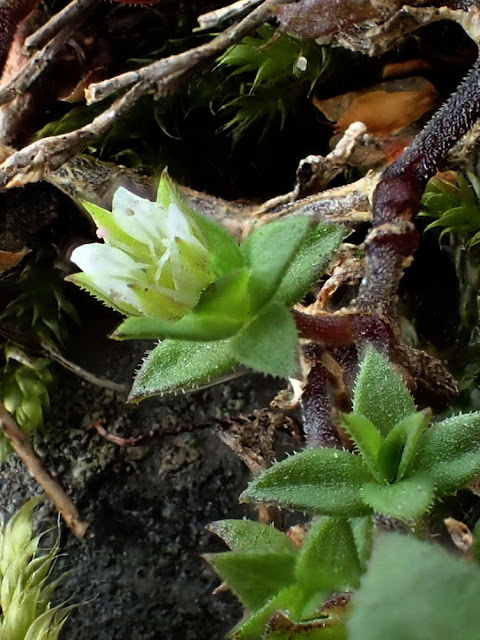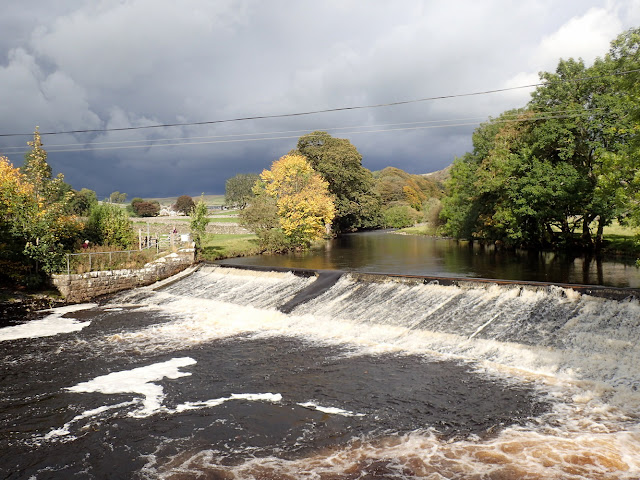St John's church is surrounded by tarmac except for a few yards of gravel and a few metres of hedge and a tiny flower bed.
Yet an examination of the surrounds, with the help of a hand lens revealed nine species of wild plant still in flower on 17 Oct and a further vistit on 18 Oct brought the total to 12 species. I list them at the end. Two of these were new green plants:
1. Ivy (Hedera helix) in full flower and 2 Procumbent Pearlwort Sagina procumbens. A months earlier I had recorded Annual Pearlwort Sagina apetala whilst out with the Hub group walking past the Fire Station so I include that here too.
1. Ivy (Hedera helix)
Ivy is good for insect pollinators. See this article from From University of Sussex http://www.sussex.ac.uk/broadcast/read/19003
- · On average 89 per cent of pollen pellets brought by worker bees to hives were from ivy. There was no difference between hives located in an urban (Brighton) versus a rural area (University of Sussex).
- · 80 per cent of honey bees foraging on ivy were collecting nectar not pollen.
- · Ivy nectar was high quality, with a lot of sugar (49 per cent).
- · Ivy flowers are visited by a wide range of insects, such as late-season butterflies, hover flies, other types of flies, wasps, bumble bees, and the ivy bee (a bee that specialises on ivy). Insects were attracted to ivy flowers in large numbers in both urban and rural areas.
- · Ivy is common and available to insects in both town and countryside.
I first saw ivy in flower on 27 Sept, near the mast at the summit of Craven Bank Lane:
There is another variety/species of Ivy that is spreading along the Railway embankment next tot Ashfield Carpark and smothering everything else.
I first recorded ivy in the blog as fruit on 25 April at Giggleswick Golf Course Course

2. Procumbent Pearlwort Sagina procumbens
 |
Procumbent Pearlwort on Tarmac
outside the Large Meeting Room,
St John's Methodist Church Settle on 17 Oct
|
I think what you can see above at each flower is 4 sepals then virtually no petald, then the fruit has split open.
 |
Procumbent Pearlwort in yard at back of St John's 27 Sept
|
 |
Procumbent Pearlwort in cobbles below Settle Coop 20 April
|
3. Annual Pearlwort Sagina apetala
Sagina apetala is an annual. It is a little tuft, and the shoots are growing upright. It does not have vegetative shoots crawling along the ground as does Procumbent Pearlwort. This was found at the boundary of Settle fire station on 10 Sept but I expect it is still there.
Total wildflowers in flower Plants in St Johns Surrounding yard on 18 Oct:
Bittercress
Herb Robert
Fox and Cubs
Welsh Poppy
Rough Hawkbit
Smooth Sow Thistle
Dandelion
Ivy
Procumbent Pearlwort
Petty Spurge
Nettle
Green Alkanet (brought originally from Settle Allotment)
 |
Rough Hawksbeard at
Entrance to St John's Methodist Church, Settle
Looking vertically down through these flowers
you see the view below |
 |
Leaves: Fox and Cubs - stolons (creepers)
Yellow inflorescences: Rough Hawksbeard
Bud on thicker whiter stalk bottom left: Fox and Cubs Bud
Tiny narrow almost grass-like tiny leaves at bottom: Procumbent Pearlwort |
A huge Thank You to Mary in the adjacent house who maintains the flower beds so well at the church entrance. We all appreciate them.
And Thank you to those at the church who look after our small remaining flower bed and hedge at the church - I am really pleased you left some wildflowers there too.






